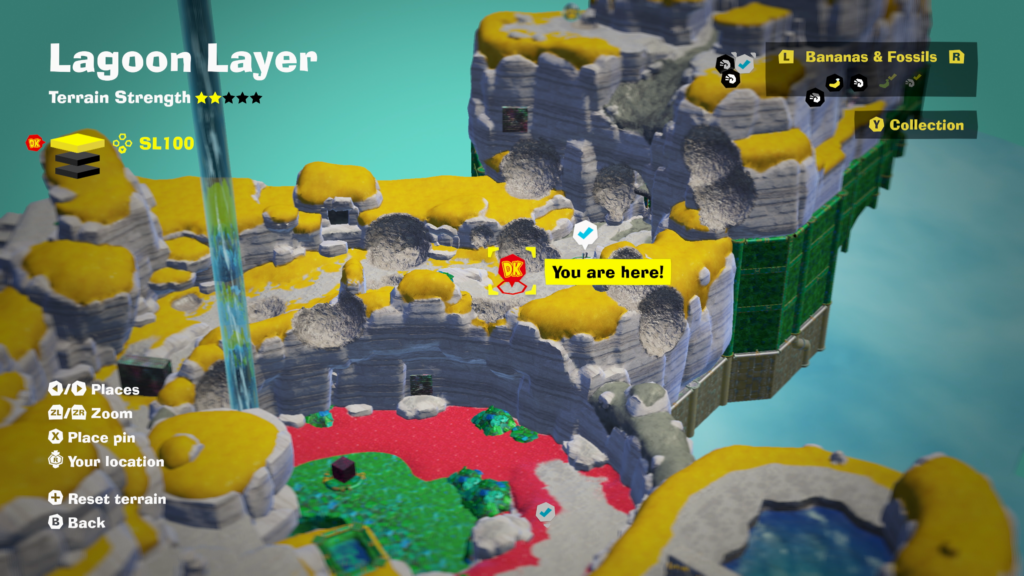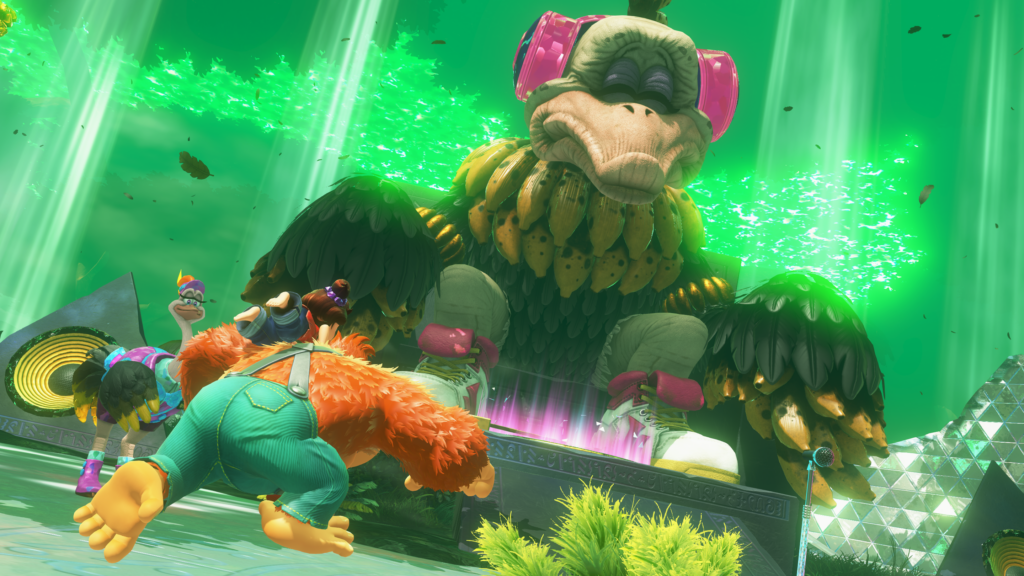When I first looked upon the trailer of Donkey Kong Bananza, I yelled – Super Mario Odyssey 2! And I wasn’t that far off, since the same team develops Donkey Kong Bananza. Am I sad that this game isn’t Super Mario Odyssey 2? No, not by a long shot. Donkey Kong Bananza shows what can be achieved if you give a character a bit more freedom than Mario sometimes lacks, since he’s still human. Donkey Kong brought the game to newer depths (actually heights, but that won’t work in this review). And I’m only upset that this wasn’t an actual launch title. Let’s dig in!
DK – Donkey Kong
Donkey Kong returns for a brand-new 3D platforming adventure, and this time, it’s not just about bananas — it’s about what lies beneath. After discovering a mysterious power source known as Banandium, Donkey Kong and a young, adventurous Pauline are sent plummeting into the depths of Ingot Isle, a jungle paradise riddled with secrets. The culprit? Void Corporation — a shady organization led by a trio of twisted new Kongs: Void Kong, Grumpy Kong, and Poppy Kong.
The narrative is simple but effective. DK sets off to explore the island’s underground layers, recover the stolen Banandium gems, and prevent Void Co. from using them to reshape the world. Along the way, he frees Pauline from a crystal prison, teams up with a mysterious rock-like creature, and discovers ancient tech-powered temples that hint at a long-lost civilization. It’s the kind of pulpy, treasure-hunting adventure that fits Donkey Kong like a glove — packed with personality, big expressions, and cheeky humor.
Gameplay & Bananza Powers
When I played the demo in Amsterdam, I was hooked. This game screamed fun, enthusiasm, and passion. It was more than a game about destroying layer by layer. It demonstrates why 3D platforming games are enjoyable when you add enough creative freedom to the mix. The villains and story are both key elements that make Donkey Kong an engaging character. Each boss you beat adds to the strength of the wildest ideas the developers could come up with, making use of the best of DK’s new abilities to beat them (and again, and again).
As I mentioned earlier, at its core, Donkey Kong Bananza is a vibrant 3D action-platformer with an open-ended, layered underground structure. Think Donkey Kong 64 meets Super Mario Odyssey, but with a focus on digging, smashing, and transforming the environment. Minecraft Kong would have been an option as well.
Each of the game’s regions — or layers — is a massive, interconnected biome filled with destructible voxel-style terrain. DK can punch, roll, or ground-pound his way through rock and metal, carving his paths to uncover hidden rooms, unlock shortcuts, and discover secrets buried deep in the walls. There’s a strong sense of physicality to every movement — the tactile smash of DK’s fists never gets old. And if you destroy a bit too much, you can always return the layer to its original state.
And then there are the Bananza Powers. Throughout the game, Donkey Kong absorbs the essence of Ancient Records, unlocking transformations like:
- Kong Bananza – a bigger, better, faster, and stronger version of Donkey Kong that can smash through (almost everything.
- Zebra Bananza – a zebra version of Donkey Kong, which focuses on speed and can run over even the most breakable terrain.
- Ostrich Bananza – an ostrich version of Donkey Kong, which can fly, glide, and drop egg bombs on enemies/terrain elements.
- Elephant Bananza – an elephant version of Donkey Kong, which can vacuum terrain and clean up layers as easily as you say BANANZA. Sucked up parts of the layers can be used as projectiles and stored for later use.
- Snake Bananza, a snake version of Donkey Kong, which can use hypnosis to slow down enemies/platformers and use the power of jump to reach even higher places that couldn’t be reached before.
These transformations are more than gimmicks — they open up entire areas, create puzzle-platforming opportunities, and make revisiting earlier levels with new powers feel genuinely rewarding. You’re encouraged to experiment, to see what breaks under your fists or bends to a new power’s logic. And with each layer, you discover the game gets more creative and challenging. Don’t stop at the first few layers – bust through and keep digging until you have all the Bananza powers, that’s where the game starts to shine like a Banandium gem in the rough. If it’s flying with cloud-rocks, illuminating tunnels with light-rocks, or smashing through thorns with concrete, this game has it all.
Collectibles & Getaways
The game also introduces “Getaways,” cozy, customizable base camps that serve as hubs for fast travel, buying items, clothes, maps, and co-op hangouts. In two-player mode, one player controls DK while the other can choose between Pauline or the rock companion, each offering unique support abilities. And as you might expect from the ‘maps’ part, collectibles play a significant role—time to hunt for every last one of them.
You’ll chase:
- Banandium Gems – Core progression collectibles that unlock new areas. There are several on each layer, and they can be found in both boss battles and challenges (including battles and platforming), as well as hidden underground. Even talking to Cranky can earn you a banana in the end, so be sure to seek him out.
- Fossils – Fossils are used to buy ‘skins’ for Donkey Kong and Pauline. DK has two skin variants, which differ in fur color and clothing style. The fur is purely cosmetic and showcases DK in a color variant you like, while the clothes help with collecting collectibles, increasing a certain power, or decreasing a specific hazard. For Pauline, her clothes have limited choices and are usually tied to the power of Donkey Kong, with the range extending or powering up in the process.
- Ancient Record Pieces – Unlocked during story progression and tied in with unlocking the different Bananza powers of Donkey Kong.
- Records – found both by defeating certain enemies and tipping the concierge in the getaway, these records will change the music played at the getaways. It’s the ingame soundtrack.
Easter Eggs Galore
Bananza is bursting with cheeky nods to DK’s legacy. There are barrels etched with “Rarely Used”, minecart tracks shaped like old level layouts, and secret alcoves where you can spot Cranky Kong ranting about modern game design. One hidden level even plays a lo-fi remix of the DK Rap, while Pauline hums nostalgic melodies that old-school fans will instantly recognize. It’s fan service, but smartly placed and never forced. I won’t spoil the rest of them, but you are in for a treat if you know the ‘older’ DK games.
Art Style & Soundtrack
The visual direction leans toward a bright, voxel-art aesthetic. Everything looks chunky, tactile, and handmade — the destructible terrain, in particular, gives the entire world a physical “toybox” feel. While it lacks the painterly realism of Rare’s Donkey Kong Country trilogy, it makes up for it with expressiveness and personality. Every punch shatters in satisfying explosions of color, and the depth-based lighting adds a real sense of mood as you descend further into the underground.
Musically, Bananza is a blast. The soundtrack blends bombastic orchestral themes with tropical percussion and synth-driven remixes of classic tracks. Pauline even takes center stage in several vocal pieces during rhythm-based ‘challenges’, giving the game its own “musical number” moments that feel fresh and joyful. But let’s be honest — not making the cartridge yellow? Criminal. A game this bananas deserved a loud, collectible shell to match. Oh, but please, don’t take the paint to yourself; one gamer did and ruined both their game and their Switch.
Conclusion
Donkey Kong Bananza is precisely what it needed to be: a confident, creative return to 3D for one of Nintendo’s most iconic mascots. It doesn’t try to reinvent the genre, but it digs deep and evolves it into something that makes Donkey Kong fun: satisfying movement, environmental interaction, and personality-packed worlds. The underground theme works surprisingly well, and the Bananza Powers keep things inventive from start to finish. It might even overshadow Mario Kart: World in terms of gameplay elements, which might have been the reason why Donkey Kong Bananza wasn’t a launch game. Luckily, it was well worth the wait. It’s my game of the (half) year with a solid golden score and a subtle urge to collect everything towards 100% completion.






